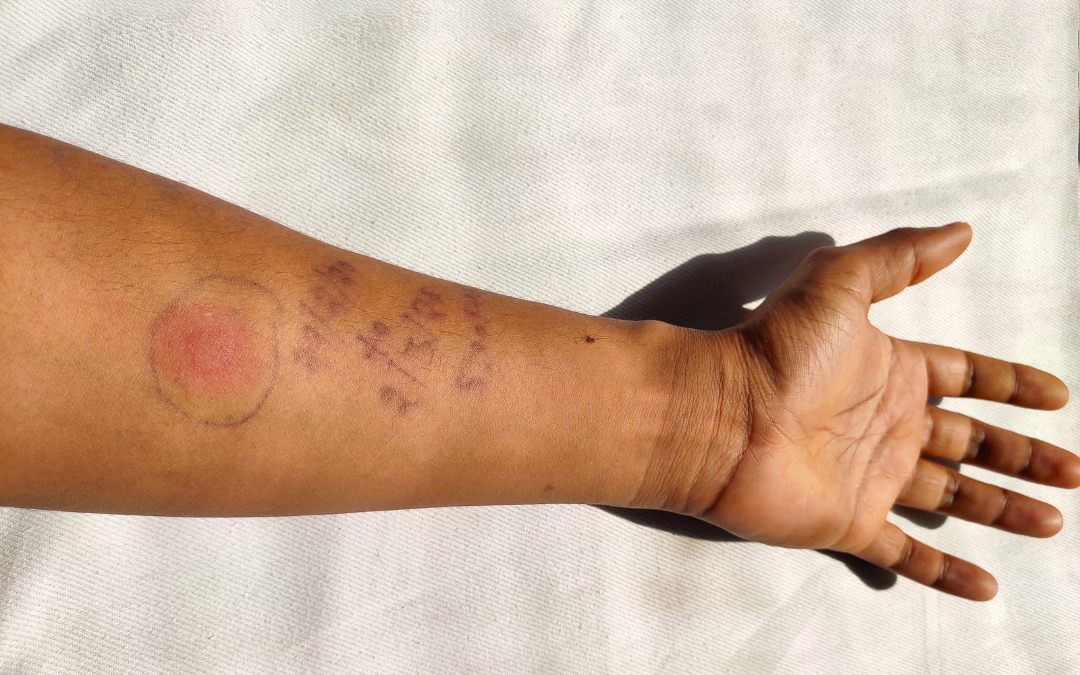When it comes to preventing and controlling the spread of tuberculosis (TB), early detection and treatment are crucial. In British Columbia, Canada, TB testing is a vital tool in identifying and treating individuals who may have been exposed to this infectious disease. Many post-secondary school programs and work settings require screening prior to entry. In this post, we will break down the basics of TB skin testing in BC, who should get it, workplaces and employees who may need a TB Skin Test, who is qualified at our clinic and discuss everything you need to know about TB.
Understanding the Significance of Tuberculosis and its Testing

The Science Behind the TB Skin Test
Unraveling the mystery behind the TB skin test starts with understanding that it operates on the principle of our body’s immune response to TB-causing bacteria. Intriguingly, this test doesn’t take an inside look at your lungs or require a lab analysis of your blood. Instead, it involves a quick and simple procedure right on your forearm’s skin.
The test unfolds by injecting a tiny amount of a substance called tuberculin into the skin. This substance is no alien invader; rather, it’s an extract derived from the TB bacteria. The response of your body to this injected substance provides an indicator of whether you’ve been infected with TB.
What happens next is a waiting game – the suspenseful part of the test where we wait for your body to reveal its secrets. If you’ve been infected with TB, your body will not stay silent. Instead, it’ll react by raising a hard bump at the site of the injection, usually within a 48 to 72 hours timeframe.
But don’t jump to conclusions just yet! A positive reaction, marked by the formation of a bump, doesn’t automatically translate to you having active TB. There’s more to the story. To draw a more definitive conclusion, you’ll need to undergo additional tests. A chest X-ray or a sputum test may be recommended to determine whether you have active TB.
So, the TB skin test isn’t just about ‘prick and tell.’ It’s a fascinating blend of microbiology and immunology that taps into our body’s defensive mechanisms to detect a potential TB infection. It’s science at its best, applied to safeguard our health and halt the spread of this infectious disease.
Who Should Consider Getting a TB Skin Test
While the TB bacteria isn’t picky about who it infects, some of us are more likely to cross paths with this wily intruder than others. At TMVC, we focus on individuals entering the workforce, primarily in healthcare settings. Results are often intended to establish a base-line prior to potential future exposures. So, who’s on the high-risk list?
- Healthcare Professionals, whether your employer tells you that you need to have it done, or you are taking proactive steps.
- Students or employees entering day care, school systems, and college or university where a TB Skin Test is needed for admission
- Individuals who are trying to meet admission requirements for a residential facility.
- Individuals trying to meet immigration or emigration requirements
- Individuals who require TB Testing as a medical assessment or as part of a treatment plan
Step-By-Step Guide to the TB Skin Test
The journey is simple, and rest assured, you’ll have a healthcare professional as your guide. The test begins with a gentle injection of tuberculin – our main character – into the skin on your forearm. The amount of tuberculin is minimal, and the injection, just a quick prick.
So, you’ve got the injection. What’s next on the agenda? You may be tempted to keep an eagle eye on the injection site, watching for any signs of a reaction. But hold off on any arm inspection – the suspense builds up for a good 48 to 72 hours post-injection. This is your body’s time to mull over the injected tuberculin and react, if necessary.
After this waiting period, you’ll revisit your healthcare provider. If your body did react to the tuberculin, a bump would have formed at the injection site. But it’s not just about the presence or absence of a bump; it’s about the size too. Generally, a larger bump could indicate a positive result. However, this isn’t a one-size-fits-all situation. The bump interpretation can hinge on several aspects – like your overall health and specific risk factors for TB.
Before you leave, let’s clear one thing. Seeing a bump might leave you anxious, but remember, this isn’t the final verdict on whether you have active TB. It’s merely a signal that your body might have crossed paths with the TB bacteria. To confirm active TB, you’d need further evaluation with additional tests, as previously discussed.
This is a snapshot of the TB skin test journey. It’s a simple yet critical tool, calling upon our body’s immune responses to give us potential clues about a TB infection. So, if you find yourself in the high-risk category or you’re just a proactive health advocate, don’t hesitate to embark on this test. After all, it’s not just about you – it’s about keeping our BC community safe and healthy too.
What do the Skin Test Results Mean?
Interpreting your TB skin test results can seem a bit like solving a puzzle, but it’s simpler than it appears. A negative result generally indicates that your body is free of TB germs, and additional testing is typically unnecessary. However, a positive result implies that TB bacteria may be present in your body. Don’t panic! This doesn’t imply you’re immediately contagious or barred from regular activities like school, work, or volunteering. It does mean, though, that you should brace yourself for further evaluations – potentially including a TB blood test, chest X-ray, or sputum samples to determine if active TB disease is present. Should your results come back positive, make a note of it – future skin tests won’t be necessary, and this result will serve as evidence of your status. Regardless of the outcome, remember this is just a step in the process, and your healthcare provider will guide you through the subsequent steps based on your results, reasons for testing, and overall health condition.
Possible Reactions to the TB Skin Test

In very rare cases, a life-threatening allergic reaction, anaphylaxis, can occur. Symptoms can include hives, difficulty breathing, or swelling of the throat, tongue, or lips. If you experience any of these symptoms after leaving the clinic, immediately call emergency services. Despite its rarity, healthcare providers are prepared to handle this emergency, which includes administering adrenaline and an immediate transfer to the emergency department. Always remember to report any serious or unexpected reactions to your healthcare provider. Understanding possible reactions to the TB skin test can ensure you’re prepared and can respond appropriately if necessary.
Now You Know
Wrapping it all up, the power of awareness and early detection cannot be emphasized enough when it comes to combating Tuberculosis. Regardless of where you reside – BC or beyond – understanding the nitty-gritty of TB testing, its importance, and the science behind it. Let’s not forget, a TB skin test doesn’t measure immunity nor is it a vaccine against TB; it is, however, a vital instrument for early detection. If you are an employee and require a TB Test or need any requirements met, book an appointment with TMVC today and we can get you started on your journey!






